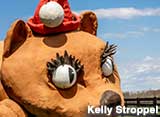
Trunkations
Road trip news, rants, and ruminations by the Editors of RoadsideAmerica.com
Conspiracy Thinking and Bathroom Convenience
March 4, 2024
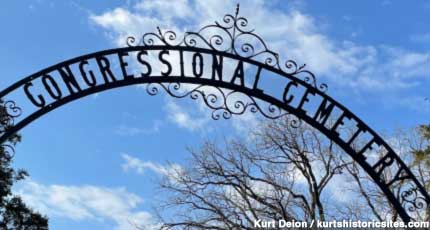
The official name of an attraction can make all the difference in our decision to detour, or even stop to investigate. We sometimes refer to a point-of-interest by a nickname we’ve coined, to clarify its oddity-appeal, while improving the chance our readers may visit in person. The dull-sounding County Historical Museum of Prairie Quilts may camouflage its true treasure: a petrified organ grinder’s monkey rolled in a cursed rug (We made that one up, but you get the idea).
In the world of real attractions, some people allow a name to nourish their fantasies a bit too much.
Take for example, Congressional Cemetery in Washington, DC. Tourists sometimes think that it’s an official government graveyard — and it isn’t, assured Cemetery president Jackie Spainhour. “‘Congressional Cemetery’ is a nickname that just stuck,” Jackie said. A few congresspeople are buried there, but they’re tiny fraction of its 67,000+ burials. Congressional Cemetery is just easier to say than its real name: Washington Parish Burial Ground.
But that simple — perhaps too simple — explanation doesn’t cut it with one group of overly alert outsiders. “We’re near the DC jail where the January 6 insurrectionists are being held,” Jackie said, “and the protestors outside the jail think we’re a government cemetery.” This is a key misunderstanding, Jackie said, because some protestors had a theory that “[President] Biden was conspiring with us so that we could kill the prisoners and bury them here in secret.”
Jackie added, dryly, “We’re not doing that.”
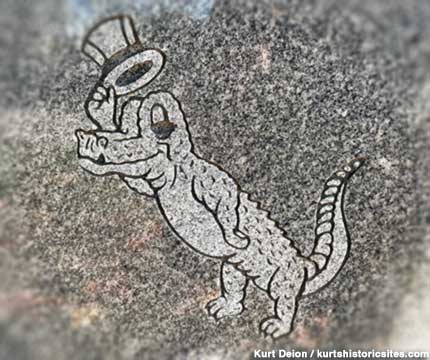
Would it, we asked, be enough of a reason to change the cemetery’s name? Jackie said no, and added that despite the protestors’ mistrust, they don’t perceive the cemetery as so evil that they can’t occasionally pop in for a visit. “Every once in a while,” Jackie said, “they’ll come by to use our bathroom.”
Sections: Places
No Comments »
The Cave Doctor
January 23, 2024
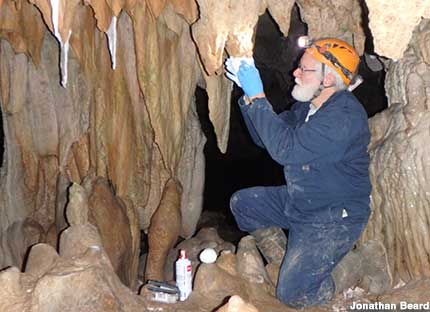
Explorers and tourists in the past have abused caves, snapping off stalactites and other formations for souvenirs, leaving only stumps. That isn’t tolerated any more, but the damage had been done and was irreversible.
Until now! Fantastic Caverns in Springfield, Missouri, is having its past mutilations repaired — by Jonathan Beard, a Cave Doctor.
Jon worked at a 3M adhesive plant, where he became familiar with epoxy. He was also very familiar with caves (Missouri has over 7,500). Jon told us that he’d spent decades as an amateur caver, photographing and mapping subterranean passages beneath the Ozarks.
Combining these two areas of expertise, Jon found that epoxy putty could not only be used to glue a broken piece of cave back into place — in the rare instances when the original could be found — but could also be shaped to create entirely new, replacement formations: prosthetic stalagmites, stalactites, columns, canopies, draperies.
With the help of an apprentice, Sarah Peterson, Jon went to work in Fantastic Caverns in late 2022. When we spoke to him in January 2024, he and Sarah had already fashioned and attached over 1,250 one-of-a-kind replicas.
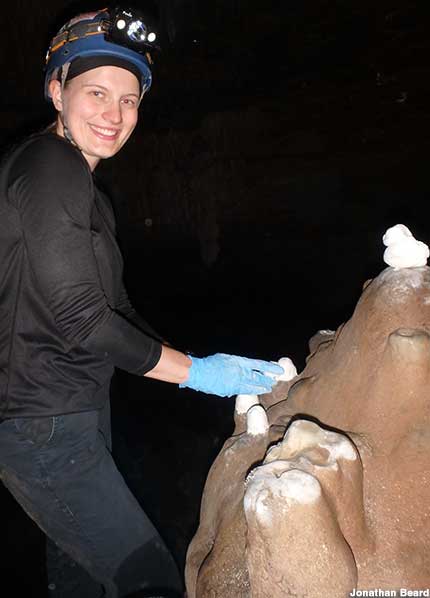
Cave formations don’t just happen: they’re formed over centuries by dripping water. So, after sculpting and attaching an epoxy stalactite or drapery (the larger ones are made hollow to save weight) Jon will spray it with water to see how it drips, then adjust the shape so that the water falls in the precise spot it did when the formation was whole. Jon’s replica stalactites are positioned so accurately that they can resume their interrupted drip-drip job of forming the stalactites beneath them.
Jon also understands what a speleothem — the generic word for a cave formation — should look like. After individually sculpting each prosthetic in place — making it the right size and shape to the eye — and waiting for the epoxy to cure, he then blends various paint colors onto the replacement formation to match the already existing parts as closely as possible.
One benefit to Jon’s approach, he said, is that given enough time the water dripping down and over his prosthetics will encase them in real minerals, making them indistinguishable from genuine speleothems. Of course, that won’t happen for several hundred years, but it’s something nice to think about.
Jon told us that when he and Sarah complete their work in Fantastic Caverns, which should be some time this Spring, they will have replicated around 1,500 formations. They’re also doing similar work in nearby Bridal Cave, but after that Jon hopes that someone like Sarah can take over. Jon is in his seventies, and his subterranean work is wet, dark, and contorts him into awkward positions. He loves caves, but he told us that he would also “love to act like a retired person” and spend at least part of his remaining years in a place that’s warm and above ground.
Sections: Places, Trends
Comments Off on The Cave Doctor
Memories of a Seventies Punk Rock Tourist
December 3, 2023
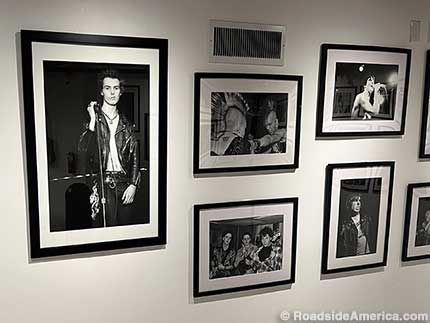
The Punk Rock Museum opened in 2023 in Las Vegas. We visited in June, a few months later. The collection is crammed with artifacts from 50 years of punk culture, filling every space with huge blow ups of concert photos, and thousands of images, art, posters, and zines.
The museum’s inaugural special exhibit features concert images by photographer Rikki Ercoli. We know Rikki from our college days on Venue Magazine (he was then called “Spacerick.”). In the 1970s he jumped into the Philadelphia and New York club scene with his 35mm camera and b/w film, following Patti Smith, Sex Pistols and the Ramones.
Now living in San Francisco, he recently talked about the exhibit, and how he “loved the sarcasm of the punk bands.” Fanatical in his desire to see every act that came to town, Rikki captured images of the early luminaries, such as Debbie Harry and Sid Vicious (framed prints are available for purchase in The Punk Rock Museum gift shop).
Rikki went to South London for a college semester via a student exchange program. “I wanted to see Generation X and X-Ray Specs. That’s why I went — not for school.”

Ercoli’s work documents the excitement of that early era and freezes moments, from a music fan’s point of view, in small clubs and larger venues. “I was trying to capture the history of that time,” he said.
He was blown away when he made the connection with the Vegas museum and their enthusiasm for sharing his work (an earlier showing in a Washington DC gallery had been cancelled during the pandemic). Rikki joked, “They had to build a museum just to show my friggin stuff!”

Rikki was in Las Vegas for the exhibit opening — and thrilled to see the breadth of punk across the years on display. “It is funny they have Joe Strummer’s last bag of weed.”
The Ercoli photographs are exhibited at The Punk Rock Museum until the end of 2023.
Sections: Places
Comments Off on Memories of a Seventies Punk Rock Tourist
Is Taxidermy Dead?
October 28, 2023

Several recent news stories suggest that displays of animal taxidermy are becoming extinct at mainstream establishment museums. They are viewed by the academically trained — those in charge — as controversial embarrassments and, worse, old. After all, the thinking goes, wouldn’t everyone be happier strapping on a VR headset and stumble-frolicking with digital wildlife?
And let’s not ignore the effects of climate change. In October 2023, the Carnegie Museum of Natural History in Pittsburgh removed its diorama of lions attacking a camel, on display for over a century, because it was judged to be emotionally “harmful” to modern visitors. In August the Delbridge Museum of Natural History in Sioux Falls simply closed its doors forever — because its outgassing animals, dead for over 40 years, were now feared to be a menace to human health.
Yes, there is a measure of revenge-beyond-the-grave in that latter story, but it still seems like an air scrubbing overreach.
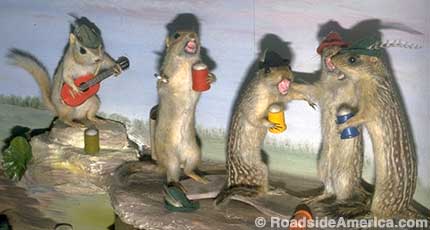
Yodeling bar life of Hayward, Wisconsin.
Yet even while mainstream museums are mothballing their taxidermy, smaller attractions are keeping our stuffed animal pals in the public eye. Taverns and saloons, for example, have always been safe houses for taxidermy that might be shunned elsewhere. And while there has always been an appreciation for the well-preserved fur-bearing trout or a crusty merman, new taxidermists are now reimagining earthly fauna (mostly using creatures that were already deceased) into fantastical forms.
The future of taxidermy may be on the fringes of tourism, but it seems nonetheless bright in a place such as the Wacky Taxidermy and Miniatures Museum. Its displays are created by a couple of 30-somethings, and they craft a kind of stuffed animal art that you would never see in the stiff-necked Smithsonian, not even in a 5-D simulation.
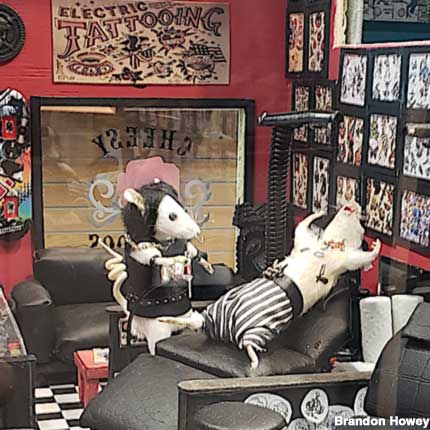
Wacky Taxidermy and Miniatures Museum, Mackinaw City, Michigan
Sections: Places, Trends
Comments Off on Is Taxidermy Dead?
Belated Burials: Expired, Unidentified, and Famous!
October 4, 2023
Fans of bizarre tourist attractions saw their travel plans disrupted recently when it was announced that Stoneman Willie, a preserved corpse on display since 1895 in Reading, Pennsylvania, had finally been identified and would be buried under his real name. His imminent interment was teased to Reading when his casket appeared in a motorcycle hearse at the town’s 275th anniversary parade last weekend, and his funeral home stewards kept him available for public farewell viewing this week in all his empty eye socket snaggly-toothed charm.
Stoneman Willie is the latest body entering the “proper burial” stage of Dead Guy Fame. He’s one of a dying breed of already-dead people. The posthumous population peaked roughly a century ago. Usually what would happen is that an unidentified stranger would expire in a town, then the local undertaker would embalm the corpse, prop it up in a chair or a corner of the casket showroom, and hope someone would recognize it (and pay the aftercare bill).
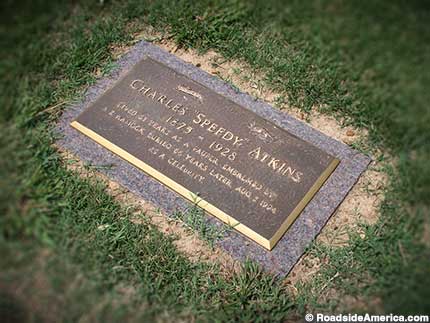
There’s no way to know how many times this was done and resolved fairly quickly, but a few display corpses went unclaimed — lighting up the nightmares of local children — for decades, long enough to become unofficial local attractions. The lonely corpses with no apparent next-of-kin were viewed with affection by owners, usually descendants of the original embalmer — a family heirloom equivalent to grandpa Ezekiel’s taxidermy weasel lamp, or Aunt Ethel’s wig.
In that respectful spirit, we offer this brief guide to America’s Belated Burials:
• Speedy – Paducah, KY
Real name: Charles Atkins. Died 1928, buried 1994.
Named Speedy because he never moved.
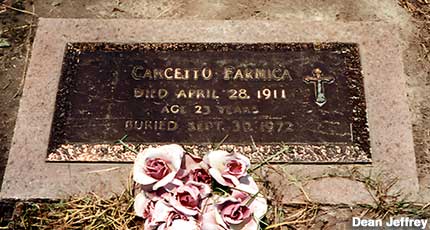
• Spaghetti – Laurinburg, North Carolina
Real name: Cancetto Farmica. Died 1910, buried 1972.
Named Spaghetti because he was Italian. He was a traveling carnival worker who got hit by a tent stake during a fight.
• Eugene – Sabina, Ohio
Real name: unknown. Died 1929, buried 1964.
Named Eugene because a paper in his pocket had the address of a vacant lot, and the living neighbor next door was named Eugene.
• David Elihu George – Enid, Oklahoma
Real name: John Wilkes Booth. Died 1903, buried ?
This stranger, who some believe was really Lincoln’s assassin in disguise, was embalmed and displayed in Enid for 40 years before being sold to a circus. In the early 2000s we were told he was in the hands of a private collector in Virginia.
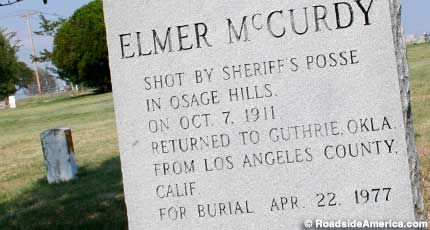
• The Dummy – Guthrie, Oklahoma
Real name: Elmer McCurdy. Died 1911, buried 1977.
Luckless Old West criminal spent his last post-life years covered in day-glo paint in a spook house before he was rediscovered (during a “Six Million Dollar Man” TV series location shoot) to be a corpse and buried.
• The Mummy – Middlebury, Vermont
Real name: Amun-Her-Khepesh-Ef. Died 1883 BC, buried 1950 AD.
Son of an Egyptian Pharaoh. His postmortem fame has cratered; even his gravestone has been removed.
And there are at least two places in America where embalmed bodies are still cheerfully exhibited:
• Sylvia & Sylvester – Seattle, Washington
Official ambassadors of Ye Olde Curiosity Shop. Sylvia’s origins remain murky, but Sylvester had the corpse name “McGinty” in the 1890s. He was embalmed after being shot in Arizona.
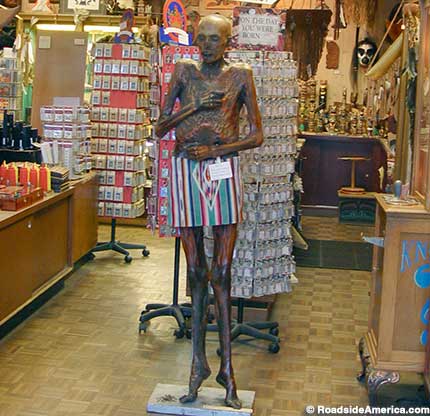
• Mummies of the Insane – Philippi, West Virginia
Long-time residents of the Barbour County Historical Museum. Previously living residents of the West Virginia Hospital for the Insane. Not mummies. They were embalmed in 1888.
May they outlive us all.
Sections: Places, Rants
Comments Off on Belated Burials: Expired, Unidentified, and Famous!
Giant Twine Ball Rolls To A New Home
September 27, 2023
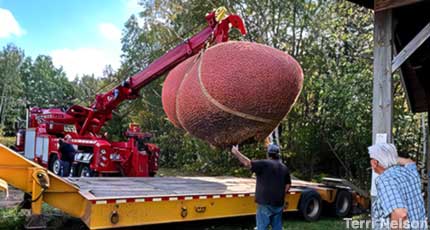
The giant twine ball of the late James Frank Kotera (a.k.a. JFK), all 12 tons of it, was safely trucked to its new home in Lake Nebagamon, Wisconsin, on September 21, 2023. The move was organized by one of JFK’s neighbors, Terri Nelson, who suggested the idea at his January funeral. According to Terri, JFK’s sister was surprised by the idea, because she had planned to bury the twine ball, thinking that no one would care about it.
JFK called himself “World Famous Dump Man” because he had spent years working at a nearby transfer station sorting the dropped-off trash and recyclables. The transfer station has been named in his memory, and it became the final destination of the twine ball — not to be recycled, but to be permanently displayed on a new concrete pad. It’s also next to the town hall: a place of honor.
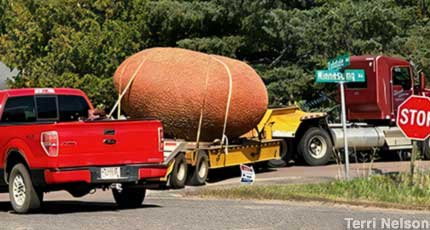
Special equipment had to be brought in to handle the massive orb — all of the labor was donated — and Terri told us that she feared that the ball would fall apart when it was lifted from the spot where it had sat outdoors for the past 40+ years. But JFK had always boasted of his tight winding technique, and the ball held together to make the move with all of its twine in place.
For now, the twine ball is covered by a tarp. Terri said that the town plans to build a permanent canopy over the ball, similar to the one that had sheltered it in JFK’s back yard, before the winter snows arrive.
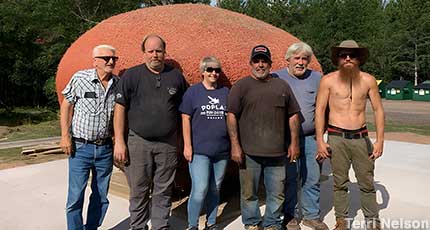
Sections: Places
Comments Off on Giant Twine Ball Rolls To A New Home
« Previous Entries



